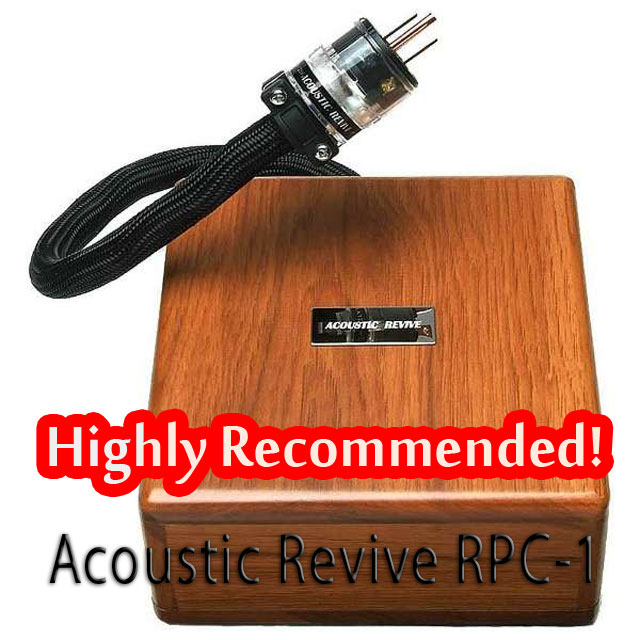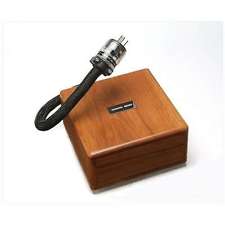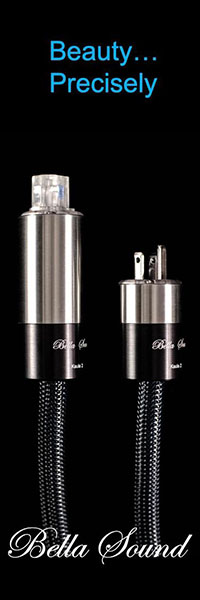Acoustic Revive RPC-1

Are you happy with the current state of your system?
 I’m going to surmise that most of the people reading this article are typically in flux about how they would answer that question. We are Audiophiles after all!
I’m going to surmise that most of the people reading this article are typically in flux about how they would answer that question. We are Audiophiles after all!
This means that as happy we may be, some days there are times when we wonder if another little tweak, here or there, could push the system a little further upward. Onward. Hence, helping us feel the connection to our music more intensely.
With that objective in mind, let me tell you of my experience with the Acoustic Revive RPC-1 AC Conditioner.
The Whys and the Wherefores!
According to Acoustic Revive’s web site (which is a good read and I highly recommend you go wander around there a bit!) ….

The RPC-1 has been jointly developed by a HWT and Acoustic Revive partnership. It is based upon the original idea of the late Mr. Shibata (who invented the infrared mouse). This ground-breaking new power supply conditioner reduces the super high frequency noise in the supply path. This results in a sound which has improved dynamics and energy with an improved signal to noise ratio.
Ok, that gives a thumbnail sketch of the technology behind the RPC-1, but what does this tell you as to HOW it can help your system sound better. Let me walk you through the various tests I put it through to discover how it impacted my system.
As you can see from the pic the RPC-1 is a rather plain, but handsome, hickory box with a pigtail AC cord attached. The company’s instructions are relatively basic, plug it into any open outlet that is available on the circuit that your whole system is on. Even though it would show some of its effects from another room outside of the main circuit – it is most potent when interacting with your main system circuit. When I first received the unit, I knew nothing about what it did or how much it cost. No problem, let’s throw it in the system and see what happens. What could be more fun!
It was a slow start
Since I knew nothing about this product I didn’t know what to expect, but my initial impression was that my system darkened up. There seemed to be less sparkle up top. Were the highs being rolled off or covered with a light veil? Trying to look on the positive side, my sense was that at least everything was more relaxed….but…I wasn’t really happy! I thought I was missing some life and detail.
 Now, although I’m no Clement Perry, I’ve had enough experience to know not to be making definitive judgments from a short listen. Does it need to break in? Let’s give it a little more time and try different source material. So, I started to rotate through the different LP’s (I tend to play LP’s 75% of the time) that I lean on for “audiophile” listening. As it went along, I started to take note that even with this seeming reduction in the highest frequencies there were some other positive changes that started to become apparent. For instance, the entire sound stage expanded in all directions and the individual images that populated the stage all had a clearly perceived increase in the dimensional qualities of their images. Yeah! This I like. Each image not only gained in three-dimensionality but also in focus. More liking!
Now, although I’m no Clement Perry, I’ve had enough experience to know not to be making definitive judgments from a short listen. Does it need to break in? Let’s give it a little more time and try different source material. So, I started to rotate through the different LP’s (I tend to play LP’s 75% of the time) that I lean on for “audiophile” listening. As it went along, I started to take note that even with this seeming reduction in the highest frequencies there were some other positive changes that started to become apparent. For instance, the entire sound stage expanded in all directions and the individual images that populated the stage all had a clearly perceived increase in the dimensional qualities of their images. Yeah! This I like. Each image not only gained in three-dimensionality but also in focus. More liking!
Another quality started to become apparent; there was an “enrichment” to each image. The images all gained weight, not in any negative way. What I mean by that is they seemed denser. Let’s face it, we all kind of do this “suspension of disbelief” that allows us to “see” the ghostly images of notes, instruments and people hanging in the air in front of us. Well, the ghosts densified! The sense of these hanging images being three dimensional was more clearly evident! Some would describe the images as more THERE. I don’t know about you, but for me that increase in “thereness” is highly desirable!
 Let me illustrate this with an example. I was playing an LP of solo classical guitar by Michael Lorimer. Without the RPC-1 in my system, everything sounded fine. The usual ghostly image was hanging before me with fairly good focus and sense of dimension. Also, let’s not forget the focus and dimensionally of the space his instrument resided in.
Let me illustrate this with an example. I was playing an LP of solo classical guitar by Michael Lorimer. Without the RPC-1 in my system, everything sounded fine. The usual ghostly image was hanging before me with fairly good focus and sense of dimension. Also, let’s not forget the focus and dimensionally of the space his instrument resided in.
As his fingers wandered over the strings, each separate pluck had a varying intensity of launch; the beginning of the creation of the transient of that note. This is what some refer to as “musical touch”. The varying push and pull and release. These are factors in creating the nuance that animates the musical storytelling.
Of course, each pluck of a different note had a different tonal quality. However, with the RPC-1 in the system, several things simultaneously changed. The transient had the same, if not quicker, sense of speed but most certainly the launched note was richer, weightier, stronger, more apparently there!
To use an analogy, if electrical amperage connotes the volume of current flow, it sounded as though each note had more amperage! Each note and each instrument was more viscerally there! The space that surrounded each note/instrument was more clearly evident. Remember, when the stars and the moon and the system and recording all line up, it’s possible to perceive focus and dimensionally in the space surrounding each note/instrument. Therefore, the quality of that surrounding space is critical to how illuminated the images become in that space. Was all this improved clarity, dimensionality and visceral quality because the RPC-1 was sucking the noise out of the system? It beats me, but I liked it!
 Eventually, it became apparent that the enriched, dense tone was the cause of my initial sense that something was reducing life and sparkle. When instead, it was a paradigm shift. Less can be more! Like when one reduces the amount of bass coming from a sub, the mids and even highs seem stronger, more apparent, more THERE! The absorption of noise in the electrical blood supply allowed my ears to hear more signal and less pollution. Akin to driving in a car with the windows down and the radio on. Roll up the windows – reducing the noise pollution – and everything coming from the radio is more vivid and articulate.
Eventually, it became apparent that the enriched, dense tone was the cause of my initial sense that something was reducing life and sparkle. When instead, it was a paradigm shift. Less can be more! Like when one reduces the amount of bass coming from a sub, the mids and even highs seem stronger, more apparent, more THERE! The absorption of noise in the electrical blood supply allowed my ears to hear more signal and less pollution. Akin to driving in a car with the windows down and the radio on. Roll up the windows – reducing the noise pollution – and everything coming from the radio is more vivid and articulate.
Although the Acoustic Revive website talks of how the RPC –1 reduces super high frequency noise in the supply path, it wasn’t just high frequencies that benefited. Lower down through the midrange and into the deep bass, all the positive attributes just discussed were evident there too.
Let’s go back to my first impression that the RPC-1 seemed to roll off the high frequencies. After much more extensive listening, my final thoughts are that “if” it does do some rolling off it’s not as egregious as I had first thought. The reality is that the numerous positives it brings to bare far outweigh the “possible” sparkle reduction.
Here’s another example…cymbals. When I first focused on these, my sense was that they were tamped down. What I later came to realize was that instead of a whitish, silvery quality the RPC-1 reduced the hash and instead allowed a bronzy, golden hue to show through. All the detail and transient quickness were still there while being tonally more palatable and relaxed! So, after a day or two of working through these evaluations I decided to go online and see what I could find being said out in the ether.
I LIKE THIS THING!
I was only able to find a couple of formal reviews and from there I learned the cost of the RPC-1. Let me preface by stating what should by now be obvious – I like this thing, but it costs $2,250! At first, I was surprised. Maybe I shouldn’t like it!
As time with it elapsed I continued to compare all kinds of music with and without the RPC-1 engaged. Like it or not, I couldn’t escape the fact that I was just enjoying my system more…much more… with it in. Obviously, the question of value is a sliding scale. Each person must assess the cost/benefit to be derived by any addition to THEIR system.
One day, while chatting with one of my audio buds, I used him as a sounding board about my cost/benefit quandary. I finally said to him, “I just don’t want to live without this thing!” His response was “That simply says it all” and I would bet that many of you would feel the same way.
I have now had the pleasure of experiencing a handful of Acoustic Revive products and they all do something beneficial towards that goal of “feeling the music more intently.” The RPC-1 is just another impressive example of this company’s talents. Highly recommended!!
ed van winkle
Specifications:
Dimensions: W17cm D17cm H8cm
Cable Length: 37cm
Weight: 1.3kg
Website: www.acoustic-revive.com
Price: $2,250.00
US Importer: Joe Cohen The Lotus Group
Website: www.lotusgroupusa.com
Stereo Times Masthead
Publisher/Founder
Clement Perry
Editor
Dave Thomas
Senior Editors
Frank Alles, Mike Girardi, Russell Lichter, Terry London, Moreno Mitchell, Paul Szabady, Bill Wells, Mike Wright, and Stephen Yan,
Current Contributors
David Abramson, Tim Barrall, Dave Allison, Ron Cook, Lewis Dardick, John Hoffman, Dan Secula, Don Shaulis, Greg Simmons, Eric Teh, Greg Voth, Richard Willie, Ed Van Winkle, Rob Dockery, Richard Doran, and Daveed Turek
Site Management Clement Perry
Ad Designer: Martin Perry





Be the first to comment on: Acoustic Revive RPC-1